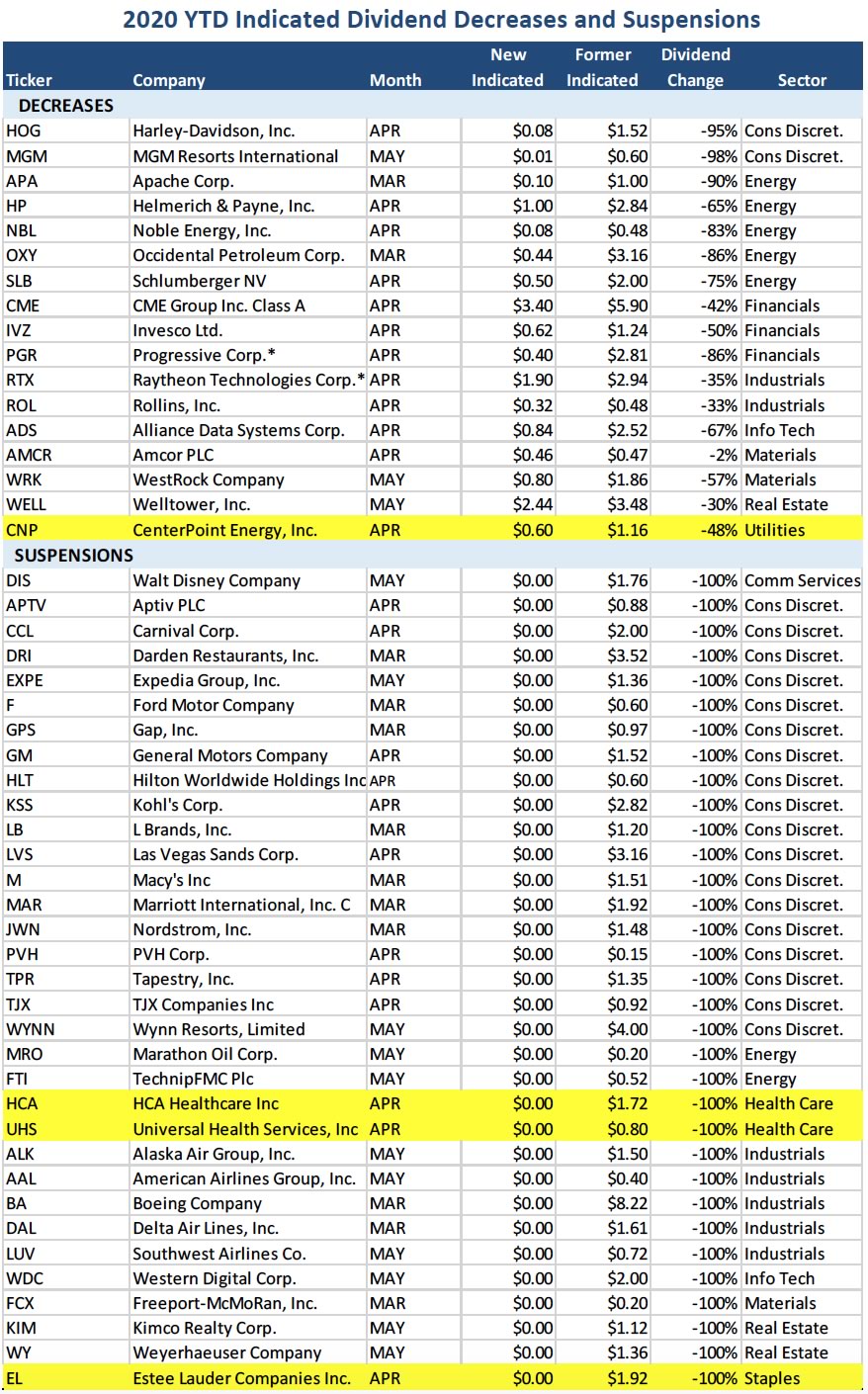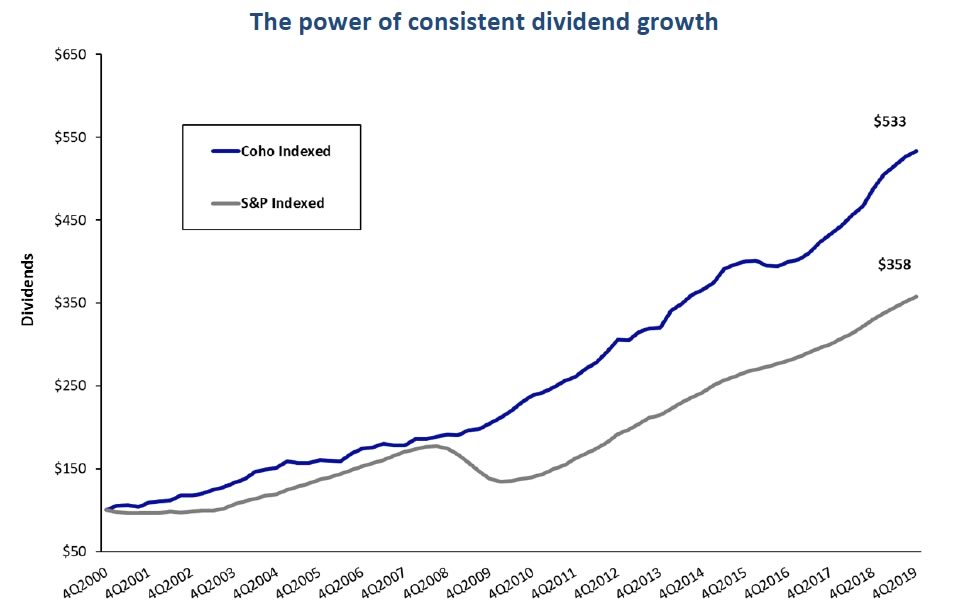A company’s capital allocation profile is an important element of Coho Partners’ investment process, with the dividend being a component of this along with internal investment, debt repayment, share shrink, and M&A activity. While we do not require every company in the Coho 250 investable universe to pay a dividend, most do and every company in the portfolio today does. In this paper we focus specifically on the dividend component given the abnormal number of dividend cuts and suspensions that have been announced year-to-date because of the COVID-19 pandemic and the related economic headwinds caused by the ensuing shutdown.
We believe a company’s ability and inclination to pay a growing and sustainable dividend sends an important signal on the health and prospects of the underlying business. Stability and growth of revenue, earnings, and cash flow are lynchpins of the Coho investment process and companies that consistently raise the dividend without experiencing a corresponding increase in the dividend payout ratio typically exhibit these characteristics. On the other hand, Coho is not interested in companies where the dividend is subject to regularly occurring economic disruptions -think autos, money center banks – where the on again/off again dividend payouts are part of the investment equation.
What is a dividend suspension versus a cut and why does it matter?
Since the beginning of the year a relatively large number of companies in the S&P 500 Index have announced a dividend suspension or cut versus what we have seen historically, with the actions driven mainly by the COVID-19 headwinds impacting revenue and earnings for many companies. What is a cut versus a suspension?
- A dividend cut occurs when a company reduces the quarterly dividend payment, either for the foreseeable future or with the intention of ultimately growing the dividend from the new lower level. In most cases, the reasons for a dividend cut are due to current financial problems often in conjunction with a less favorable outlook for the business on a longer-term basis. It often takes many years for the dividend payment to return to levels reached prior to the cut if it ever does. This happened to many companies in the Financial Services sector following the global financial crisis of 2008-2009.
- A dividend suspension occurs when a company stops paying the entire dividend for a period, usually (but not always) with the intention of reinstating the dividend at the same level prior to the suspension. A catastrophic event such as COVID-19 has clearly altered the near-term earnings outlook for many companies, particularly those exposed to service industries (hotels, airlines, restaurants, leisure, etc.). The pandemic has also forced many companies to hoard capital and ensure adequate liquidity to weather the storm, with the key unknown being the duration of the virus’ impact on economic activity and consumers’ willingness to return to a ‘new normal’.
Coho’s approach to dividend suspensions versus cuts
At Coho, not only do we believe a growing dividend signals strength in the underlying cash flow generation of the business, it also instills a discipline on management to prudently manage that cash and not squander it. Paying a growing dividend makes companies and their boards carefully assess all other forms of capital allocation and particularly acquisitions. No management team or Board wants to be in the position of having to cut or suspend a dividend because they may have overreached on an acquisition or some internal investment pursuit that was not well vetted. In our view, a dividend cut signals a clear lack of conviction in the outlook for the business or some other current financial problem, often exacerbated by excessive debt.
Nonetheless, the current COVID-19 pandemic is unprecedented in our lifetime and we believe there are a number of well-managed companies that through no fault of their own may face near-term liquidity, revenue, and cost headwinds as a result of the virus. While we would prefer not to see a dividend suspension, we believe such an action for a well-managed company is understandable, assuming the Board reinstates the dividend and moves it back to the pre-suspension level as we emerge from the COVID-19 headwinds.
Notably, none of the Coho Relative Value Equity portfolio holdings have suspended their dividends to-date, though it is possible a company like Ross Stores (ROST) could do so. The company’s stores are currently closed in most markets and that has obvious near-term financial ramifications. In any kind of normal economic circumstance, expansion or recession, Ross’ dividend would not be of concern given its resilient business model. Even in bad times the dividend was raised double digits in 2008 and 2009 during the Great Financial Crisis. Still, if it did suspend its dividend, we believe social reasons rather than financial reasons could play a role as ROST had over $1 billion in net cash (no net debt) entering the pandemic, is in a stronger financial position than most retailers, and could benefit from consumer trade-down activity if the probable recession plays out. Due to the widespread human suffering caused by this global health crisis, some Boards may be reluctant to approve a dividend payment when large scale layoffs or furloughs are being announced at the same time.
Of course, this raises several other questions such as what may happen if there is a second wave of virus infections either in the fall or because of loosening stay-at-home restrictions. Clearly, the duration of the virus and speed of therapeutic and vaccine developments will need to be monitored.
How unusual are dividend suspensions?
The table below lists the companies in the S&P 500 Index that have decreased or suspended their dividends year-to-date through May 11, 2020. We make three notable points. First, in the 10-years prior to 2020 there were just 9 suspensions in total versus the 33 announced year-to-date. Moreover, there were no suspensions in 2018 and 2019. Second, when examining the cuts and suspensions, one will notice they were overwhelmingly concentrated in what we call economically sensitive companies, which are those more exposed to cyclical areas of the economy. On the other side of the coin are what we term demand defensive companies that tend to be more resilient to economic headwinds. We highlighted the latter in yellow and one can see there was only one demand defensive company among the dividend cuts and just three among the suspensions. You may recall that as part of the portfolio construction process, we seek to overweight your portfolio to demand defensive companies and limit exposure to the more economically sensitive. Moreover, the economically sensitive companies in the portfolio tend to exhibit the least cyclicality among their peers, and this is part of the reason the portfolio has been insulated to-date from dividend cuts or suspensions. Third, while we do believe some companies will be able to reinstate the dividend to pre-suspension levels, others will probably not be able to do so.


